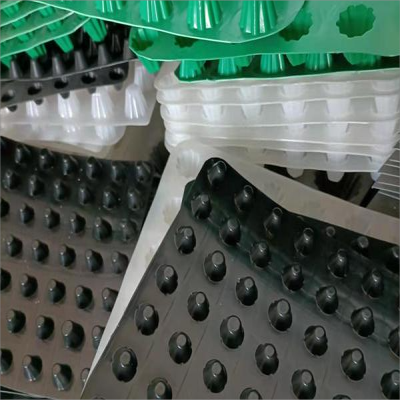1. Material selection and pretreatment
Three-dimensional plastic Drainage plate The raw materials are thermoplastic synthetic resins such as high density polyethylene ( HDPE) Etc. These materials have very good heat resistance, corrosion resistance and mechanical strength. Before production, the raw materials are strictly screened, dried and melted, so as to ensure the uniformity and stability of the product.
2. Extrusion molding process
The core production process of three-dimensional plastic drainage board is extrusion molding. This process uses a special extruder to extrude the molten thermoplastic resin through a precisely designed die to form a continuous network or strip structure. The design of the mold is key, which determines the shape, size and void fraction of the product. During the extrusion process, the resin is evenly extruded at high temperature and high pressure, and quickly cooled and shaped in the mold to form a semi-finished product with certain strength and rigidity.
3. Three-dimensional structure construction
In order to realize the three-dimensional structure of the drainage board, special molding technology should be used in the production process. Common methods include joint welding, filament winding and three-dimensional braiding. Node welding is to weld the extruded plastic threads together at the intersection point at high temperature to form a stable three-dimensional network structure; Filament winding uses mechanical equipment to wrap slender plastic fibers together at a certain angle and density to form a three-dimensional structure with excellent drainage performance; Three-dimensional weaving is to use weaving machinery to weave plastic strands according to preset patterns to form a complex and stable three-dimensional network structure.
4. Surface treatment and performance enhancement
In order to improve the performance of three-dimensional plastic drainage board, surface treatment is also required during the production process. The surface of the drainage board should be covered with a layer of geotextile as a filter membrane, so as to improve its filtration performance; Adding additives such as anti-aging agents and ultraviolet absorbers inside the drainage board can improve its weather resistance and durability; Embossing and punching the drainage board can increase its surface area and water absorption rate. By adjusting the production parameters and process flow, the physical and mechanical properties and drainage efficiency of the drainage board can be further optimized.
5. Finished product inspection and packaging
The three-dimensional plastic drainage board made through the above steps must undergo strict finished product inspection. Including visual inspection, dimension measurement, performance testing and other links. Only products that meet the quality standards can be packaged into storage and shipped to various project sites. During the packaging process, waterproof and dustproof packaging materials should be used to ensure that the products are not damaged during transportation and storage.
Post time: Feb-21-2025




